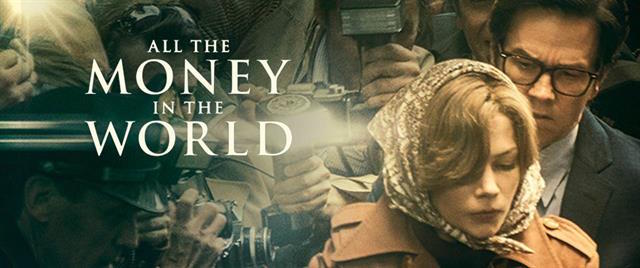
by Christina Waters | Jan 19, 2018 | Home |
What went wrong here? I wondered as the credits rolled for All the Money in the World. A film made by Ridley Scott, former genius director, current recycler of old ideas, should have been at the least visually entertaining. A film starring Christopher Plummer as the insanely rich and greedy J. Paul Getty, should have offered some serious acting chops. Confession: Kevin Spacey would have been juicy and perfect in the role as the arch capitalist oil man. But you know why Spacey was replaced by Plummer, so that’s the end of that.
Even the always-charismatic Eternal City, Rome, couldn’t manage to inject interest into this languid (i.e. boring) revisitation of the infamous kidnapping of the Getty grand-son in the 70s. The 16 year old hippie (here played by Charlie Plummer) was abducted and held for $17 million ransom. The large sum was nothing compared to Getty the elder’s billions. But he refused to pay. Here’s where things should have quickened and gotten exciting. They didn’t.
In Scott’s curiously vacant hands the scenario just isn’t complex enough to hold 2 hours of cinema.
Also, the vocal work is distracting. I imagine this: Ridley Scott called up the widow of Heath Ledger (Michelle Williams), the always-reliable Mark Wahlberg and (ultimately) the 80something Christopher Plummer. Scott sat Williams and Plummer down in front of a screening of Roman Polanski’s Chinatown. “Study those accents,” he told the two leads, as they watched Faye Dunaway and John Huston.
If you close your eyes during the Ridley Scott film, you’ll hear Faye Dunaway (doing her Katherine Hepburn thing) and John Huston delivering their lines. It is an eerie deja vu.
Then there are the excessive Italian stereotypes, liberally employed to help us hate young Getty’s kidnappers. People in the audience groaned audibly—I was one of them—as the “Italians” fought, danced, drank, laughed, and acted like the shameless, outlaw peasants that they were.
Scott forgot how to edit. He forgot how to motivate actors, and when they did muster some dramatic tension, he forgot how to give his actors lines worth saying.
Even the great Plummer, shaking his head as he examines the day’s stock market numbers, only served to remind me of the great Orson Welles as another financial giant in Citizen Kane.
To paraphrase Lord Acton: money corrupts and all the money in the world, corrupts absolutely.
What a waste of time!
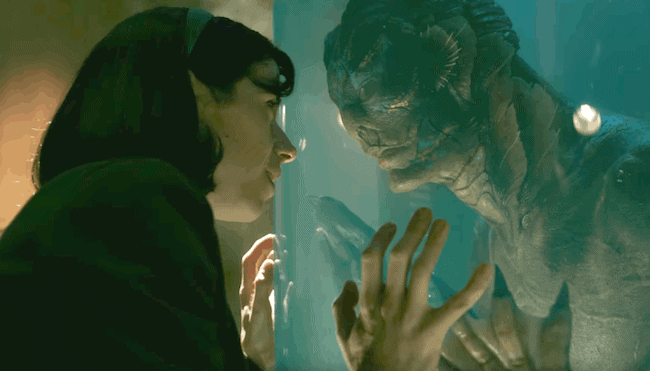
the Shape of Water
by Christina Waters | Jan 15, 2018 | Home |
Pity the poor critic who goes against the tide of public adulation. No one will thank me for not loving the heavy-handed fairy tale, The Shape of Water. No one will thank me for pointing out, against the tide if you will, that the filmmaker Guillermo del Toro, who crafted the uncanny Pan’s Labyrinth, has not repeated his success with this dark tale of forbidden love, cinema history, and diversity casting.
Short version: cross a Hallmark moment with early David Lynch—add scolding, didactic speeches and a minimalist approach to editing—and you get The Shape of Water, a showcase for characters of every gender, ethnicity, and economic background. Gently add a key disability—our heroine is mute—plus an Amazonian swamp creature (for that sexy dash of Otherness), and mix with Cold War clichés and a shocking amount of gratuitous gore and violence, and you either have a film to ride all the way to Oscar triumph…or a mess.
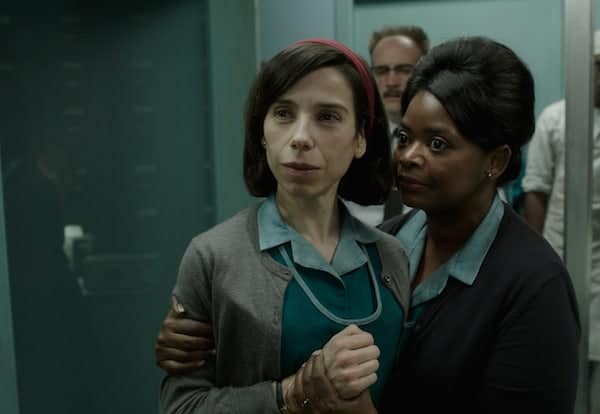
Sally Hawkins and Octavia Spencer in the film THE SHAPE OF WATER. Photo courtesy of Fox Searchlight Pictures. © 2017 Twentieth Century Fox Film Corporation All Rights Reserved
Oh how I wanted to fall in love with this film. So abundant in visual allure, such burnished color, and the irresistible crucible of forbidden love. But then why should it be forbidden? The filmmaker believes that he is not alone in treasuring the fantasy of a cross-species love. And he is not alone here. That much of the film tantalizes all of our tastebuds. It’s how he litters the trail with simplistic bread crumbs that makes, ultimately, for a flow chart of the wrong choices in this exercise in forking paths. (Sincere apologies to Borges.)
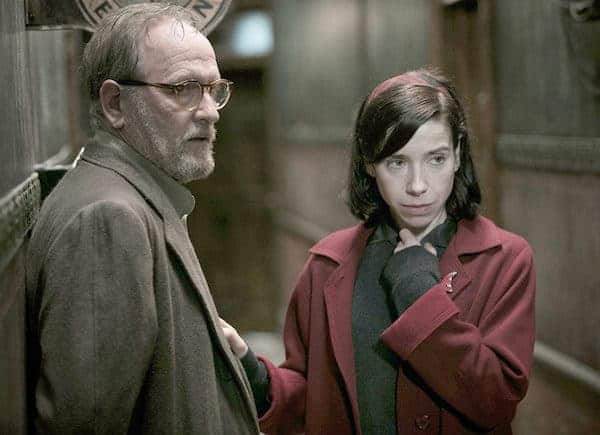 Magic realism, at its best, is a delicious elixir of visual and intellectual desire. But at its worst….let’s just say that at many crucial turns, the film implodes through its own lack of discipline. LIke a spoiled child with an expensive paintbox, del Toro indulges almost all of his fetishes whenever possible. His admirable championing of the oppressed becomes scolding and lecturing. His full rainbow of racial and gender operatives is so contrived and self-congratulatory as to grow tedious.
Magic realism, at its best, is a delicious elixir of visual and intellectual desire. But at its worst….let’s just say that at many crucial turns, the film implodes through its own lack of discipline. LIke a spoiled child with an expensive paintbox, del Toro indulges almost all of his fetishes whenever possible. His admirable championing of the oppressed becomes scolding and lecturing. His full rainbow of racial and gender operatives is so contrived and self-congratulatory as to grow tedious.
I get it: the Other is a real, living, breathing, loveable being with the same feelings, desires, and hopes that we all have. But del Toro works this obvious moral paradigm to death as if he had invented respect for diversity. I was alternately bored and insulted throughout this two hour exercise .
And then there’s the sobering realization that the film itself was growing tedious, just when all the stars have lined up to create a heartbreaking denouement. Speeches are all too long, except the ones that sling stereotypical soundbites like Marie Antoinette tossing cake to the masses.
You know the scenario by now: a loveless mute Eliza, who works nights as a cleaner in a top secret research facility, lives across the hall (above a fading movie palace) from aging, gay, artist Giles (Richard Jenkins). Eliza (Sally Hawkins) has a work buddy, Zelda (Octavia Spencer) with a heart of gold, tons of spunky attitude, and a layabout husband. (So many stereotypes!). Jenkins’ character is given to multiple, redundant soliloquies about the pitfalls of being an aging, gay artist. Yet del Toro has already shown us that well-worn situation quite clearly when Giles is thrown out of his favorite diner by the surly young owner he has a crush on.
 So much talk, talk, talk that could have become shining screen moments if only the lines, and the scenes, had been edited. Instead all the speeches are indulged, as are del Toro’s passion for the golden age of television (Dobey Gillis) and the Busby Berkeley era.
So much talk, talk, talk that could have become shining screen moments if only the lines, and the scenes, had been edited. Instead all the speeches are indulged, as are del Toro’s passion for the golden age of television (Dobey Gillis) and the Busby Berkeley era.
Sally Hawkins is wonderfully watcheable, yet her character doesn’t expand into our hearts. Ditto her work buddy Octavia Spencer who is forced to embody almost every black cleaning woman cliché that has ever seen the light of cinema. Shameless exploitation of the worst cultural models of working women, women of color, people of alternative genders, disabilities, and financial straits—all of this surrounds a central fable in which the ultimate Other is accepted by, and accepts, the yearning Eliza. How lovely this might have been had it not insulted the viewer with its elementary school lesson plan. See? the director says to us slowly and patiently, see how nicely we could all get along?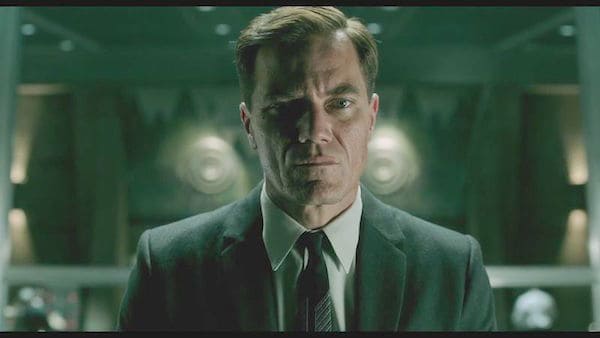
Two opposing male sexual forces drive the dramatic tension of The Shape of Water. One is the sadistic boss of the research operation—which takes place during the Cold War, hence acres of paranoia and lengthy spy meetings held in Russian. This character, Strickland, played with merciless roughness by Michael Shannon, somehow stands in for the callous, predatory American male of the 1940-50s. Del Toro unleashes him to commit sudden acts of violence—verbal, psychological, and finally physical. Especially toward the amphibious creature, kept chained in a tank of water, that Eliza begins to befriend, and then fall in love with. As sweet as Strickland is harsh, the Creature attracts Eliza, as they glide into an entrancing relationship that quickens when Strickland orders “it” killed for dissection.
Shannon is a powerhouse, as Strickland, and Strickland is a mesmerizing character, but one required to talk and pose, ponder and extol. We tire of him and his violence, long before he can ignite the finale. And the inter-plot, featuring a Russian spy who works at the research facility, and his various spy masters, bogs down rather than adding texture. Del Toro stoops to just about everything, from suburban sex and gangrenous hands, to endless quotes from 50s television. And even—shades of The Artist —the fairytale lovers at one point morph into silver screen performers, twirling and singing their way through a Fred & Gingeresque version of “You’ll Never Know.”
Instead of telling one adult fairytale of true, if magical, love del Toro decided to tell lots of stories all at once. We the audience must choose which strands taste best, and devour them if we want to leave the theater with appetites satisfied. I left hungry.

Fool’s Gold
by Christina Waters | Dec 12, 2017 | Home |
It seemed like a good idea at the time. Composer John Adams and his librettist Peter Sellars immersed themselves in the vivid letters of a New England doctor’s wife who wrote about what she observed in the gold mining camps of the 1850s Sierras. She found colorful men and women, women whose influence was clever and fast and tragic out there in the Wild West. Why not build an opera around the gritty true stories of some plucky women whose fates and fortunes were thus far unknown? The saloon dancers, Mexican camp followers, Asian prostitutes, the girls of the golden west.

Somewhere between inspiration and delivery, alas, the pungent observations of the doctor’s wife, who wrote under the pen name Dame Shirley, went awry. So much material, so few rewards. Mining for a heart of gold, the collaborators of Girls turned up mostly iron pyrite.
Occasionally, peeking out here and there from the thundering cacophany of orchestral syncopation and urgency, there were flashes of the soaring lines and engaging rhapsodies of the John Adams we know from Nixon in China and Doctor Atomic. But such moments were rare and required sitting through the over-long, under-developed arch of what remained just an idea without artistic development.
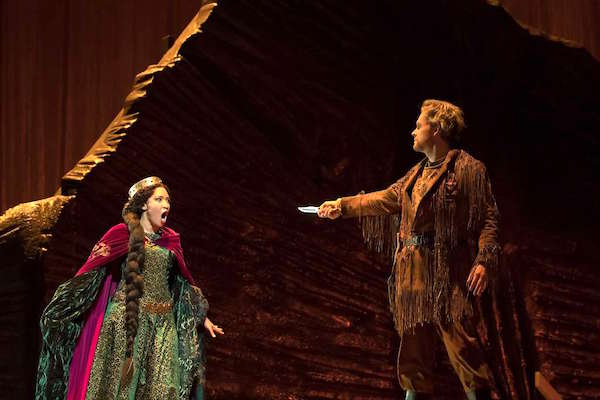 Sellars, who clearly put little energy or invention into the libretto, seemed content to clip out passages from Dame Shirley’s dispatches and have the singers essentially read them to us. Breaking the most elementary rule of theater, Sellars failed to show us the dramas being told. Even with the entire stage of the opera house he found it impossible to show us any dramatic involvement. The opera is devoid of dramatic tension [an exception, shown above, is a ravishing bit of miner’s camp Shakespeare in the form of scenes from Macbeth.] and reveals precious little in the way of actual engagement between characters. Singers came on, they sang words, the orchestra hurled itself through excruciatingly difficult rhythmic passages and then the giant stump that served as the main showcase was pushed a few feet to the left. And then a few feet back to the right.
Sellars, who clearly put little energy or invention into the libretto, seemed content to clip out passages from Dame Shirley’s dispatches and have the singers essentially read them to us. Breaking the most elementary rule of theater, Sellars failed to show us the dramas being told. Even with the entire stage of the opera house he found it impossible to show us any dramatic involvement. The opera is devoid of dramatic tension [an exception, shown above, is a ravishing bit of miner’s camp Shakespeare in the form of scenes from Macbeth.] and reveals precious little in the way of actual engagement between characters. Singers came on, they sang words, the orchestra hurled itself through excruciatingly difficult rhythmic passages and then the giant stump that served as the main showcase was pushed a few feet to the left. And then a few feet back to the right.
Rarely in the annals of opera history has so little been done with so little.
Throughout the set changes, i.e. moving the giant, ugly stump back and forth across the stage, four poor forlorn young women were positioned to either dance, strut, kick, or push a brass bed around in circles. Given no stage direction and only rudimentary choreography, their Greek chorus had all the narrative power of a junior varsity pep rally. Like much of the indecipherable staging, such moments of mining camp hijinks were frankly embarrassing.
Blatantly ugly set “design”—so minimalist as to defy basic Theater 101 strategies—was matched by unappealing costuming, and ludicrous stage direction — again by Sellars, who insisted on the tedious and distracting “open wings” agenda. Somehow the formerly gifted collaborator had forgotten everything he knew about how human beings stand, sit, walk, and become interested in each other.
The Good News
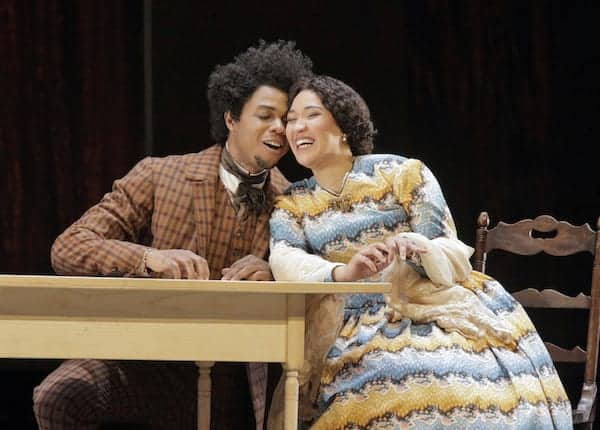 The final performance of this world premiere yielded some gorgeous singing by a vibrant young cast, powered by Adams’ beautiful arias for solo voices, soaring through the inane campfire mayhem and barroom boister.
The final performance of this world premiere yielded some gorgeous singing by a vibrant young cast, powered by Adams’ beautiful arias for solo voices, soaring through the inane campfire mayhem and barroom boister.
As Ned Banks, the freed slave companion of Dame Shirley, Davone Tines [above] was a sorcerer of physical invention and supple bass-baritone vocal power. The stage came to life every time he stepped, danced, and twirled onto it. He transformed Adams’ haunting piece based upon Frederick Douglass’ speech “What to a Slave is the Fourth of July?” into a moment of breathtaking clarity. Tines—destined for stardom—gathered together words and music with as much magic as Adams’ deeply affecting Doctor Atomic aria, “Batter my heart, three-person’d God.”
Why then was he “killed off” two-thirds of the way through the opera? Worse—we are only told that he was killed somewhere off-stage, an event that cried out for dramatization. Another rule broken: you never kill off your most popular character before the end. Once Tines was gone, the opera slowed and meandered. 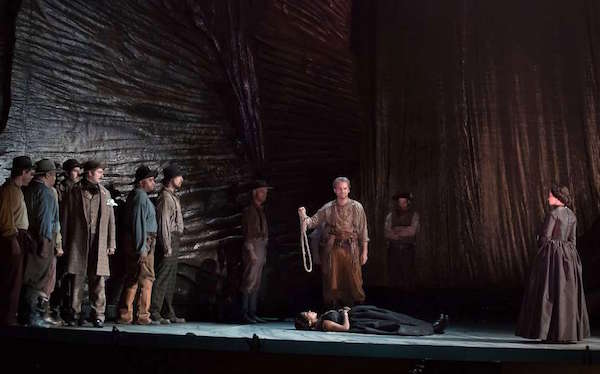
Another aria, for Josefa, a beautiful Mexican woman destined for the gallows, was sung in Spanish and English by J’Nai Bridges, whose lustrous voice gave elegance and dignity to the superbly surrealist aria Adams created for her.
 In other notable performances, Paul Appleby as luckless miner Joe Cannon brought a clarion tenor voice and persuasive acting to his on-stage antics. As another rabble-rousing miner bass Ryan McKinny offered searing moments of vocal beauty and angst. (McKinny already has at least one Wagner role under his belt, and it would be revelatory to hear Tines as Wotan one of these years.) As the raw-boned denizens of the camps, the SF Opera chorus men attacked the repetitive, Glassian declamations with appropriate bravado.
In other notable performances, Paul Appleby as luckless miner Joe Cannon brought a clarion tenor voice and persuasive acting to his on-stage antics. As another rabble-rousing miner bass Ryan McKinny offered searing moments of vocal beauty and angst. (McKinny already has at least one Wagner role under his belt, and it would be revelatory to hear Tines as Wotan one of these years.) As the raw-boned denizens of the camps, the SF Opera chorus men attacked the repetitive, Glassian declamations with appropriate bravado.
The hero of Girls of the Golden West must be the splendid and commanding Julia Bullock, making her San Francisco Opera debut as Dame Shirley (Bullock offered us the witty turnabout of an African-American performer cast as a white woman). Adams gave her some of his finest work in the gossamer opening passages as the she discovers the craziness of California, and at the very end (way too long in the making) in which she proclaims the indelible beauty of the land, transcending its raw, violent male culture.
It’s possible that there is an opera somewhere in all these many ideas—one that brings to robust and emotionally-charged life the rough world of the 19th century mining camps. But Girls of the Golden West is not yet that opera.

The Ring in Vienna
by Christina Waters | Oct 24, 2017 | Home |
Three days after the last rolling waves of the Rhine river had dissolved into thin air, the music stayed inside my body. All of the themes of Richard Wagner’s opulent masterpiece resound. They’ve seeped into me through the surge and flow of the four operas that sum up his epic vision of greed, love, power, the gods, and humanity itself. I can still hear the Rhine maidens tempting the evil dwarf Alberich, and feel the sparks and flint of his anvil forging the gold into instruments of malecious magic. The much-parodied, still overwhelming theme of Brunnhilde and her Valkyries, the sad majesty of Wotan, doomed lord of the ring and father of the gods. Siegfried‘s horn, the dragon Fafner‘s thundering mischief, the sparkling flicker of Loge, the god of fire. With luck, the music will stay and sing to me for another few weeks, until it gradually releases me from its spell.
The music not only powers the great mythology of Wagner’s Ring, the music is the saga itself. At least in the hands of maestro Peter Schneider and the consummate orchestra of the Vienna State Opera I heard this summer. Performing on the exact instruments Wagner specified,( and in the case of the Wagner horn, whose sound resembles a cross between a trumpet and a trombone, an instrument Wagner himself designed) this orchestra created the sonic bridge that took last May’s audience from the 19th century hall to the edge of Valhalla itself.
But the orchestra had help. A solid cast of singers—notably a wickedly affecting Wotan (Tomasz Konieczny), a marathon heldentenor Stefan Vincke as Siegfried, an occasionally breathtaking Petra Lang as Brunnhilde as well as two marvelous villains in the form of Ain Anger as Hundig and Falk Struckman as Hagen.
It’s a rare and costly enterprise to commit to a cycle of The Ring’s four operas—”four long operas” —in this case involving a stretch of 10 days and 16+ hours of onstage performance. To explain to a Wagner virgin that you are actually going to submit to that many hours of sitting, listening, and watching is to sound off one’s rocker. But to Wagnerites, this endurance contest is life-giving.
Once you’ve heard all four operas in close proximity, e.g. Seattle and Bayreuth perform the four operas over a brisk seven day period, you are changed forever. Each individual opera forms a poetic whole and yet points onward to the next one. The final piece, Gotterdammerung, revives all of the musical gestures, emotions, and motifs of the previous works. It both concludes—as only the destruction of Vallhalla can—and yet it lives on within the viewer. The Valhalla theme—a triumphant bolero—is a glorious, and yes, catchy motif. Less than a day after the final French horn had sounded, I was planning my next “Ring.” It is a journey in which there is no conclusion, there is only endless transformation.[below: Tomas Konieczny as Wotan.]
 Wagner’s Ring amounts to a theatrical version of the pilgrimage to Santiago de Compostela. We are all pilgrims, journeying through the voices, the stagecraft, the soaring instrumentation, the multi-dimensional myth, en route to a holy shrine. And yet the route in this case is the shrine, and every note is a sacrament.
Wagner’s Ring amounts to a theatrical version of the pilgrimage to Santiago de Compostela. We are all pilgrims, journeying through the voices, the stagecraft, the soaring instrumentation, the multi-dimensional myth, en route to a holy shrine. And yet the route in this case is the shrine, and every note is a sacrament.
Back to the performance. The opera as a complete work of music-theater belongs, as it must, to Wagner. He gives us a morality play disguised as a fairytale (Rheingold & Walküre). Much of the libretto makes no sense, but once the very first long measures of Rheingold begin, we simply don’t care. It is all about the music! A glorious orchestra, each section—strings, brass, harp—better than the next, dove deeply into the mind of Wagner and emerged with a steady outpouring of ecstatic darkness, shimmering topnotes, plush chromaticism powered by unerring virtuosity. The musicians seemed connected to both the conductor and the singers by an organic web. Utterly convincing. So perfect were the upward movements, the crescendoes, that even the high notes of trumpets seemed made of new colors.
 Some specifics about this Vienna Staatsopera 2017 production, reviving minimalist but effective staging and sets by Sven-Eric Bechtolf. Small details brought this Ring to moments of great clarity and resonance.In Rheingold, as Wotan fights for possession of the gold ring with the Niebelung Alberich, (Jochen Schmeckenbecher) the stagecraft shows us the two mythical opposites—king of the Gods, and underground-dwelling dwarf—joined by a single crimson cord. Their tug-of-war visually reminds us of how they are united in their greed, and whoever wins the gold, will lose it in the end. That single red cord, the width of the entire stage, was arrestingly eloquent of the Nietzschean tension in these opposing characters.
Some specifics about this Vienna Staatsopera 2017 production, reviving minimalist but effective staging and sets by Sven-Eric Bechtolf. Small details brought this Ring to moments of great clarity and resonance.In Rheingold, as Wotan fights for possession of the gold ring with the Niebelung Alberich, (Jochen Schmeckenbecher) the stagecraft shows us the two mythical opposites—king of the Gods, and underground-dwelling dwarf—joined by a single crimson cord. Their tug-of-war visually reminds us of how they are united in their greed, and whoever wins the gold, will lose it in the end. That single red cord, the width of the entire stage, was arrestingly eloquent of the Nietzschean tension in these opposing characters.
Ironically, I had gone to Vienna specifically to hear the great Welsh baritone Bryn Terfel sing Wotan. He cancelled at the very last minute, and Konieczny stepped in. It turned out to be a great act of fate. Konieczny is not only an attractive and dynamic stage presence, but his honeyed voice lent endless color variations to Wagner’s innovative passages powering Wotan’s existential struggles. A tremendously effective actor, Konieczny’s farewell to his daughter Brunnhilde had the audience in tears. Never before had I grasped the depth of this father’s pain upon releasing his much-loved daughter of her immortal status. In her shameful mortality, we glimpse the beginning of the end. It was a scene I will never forget.
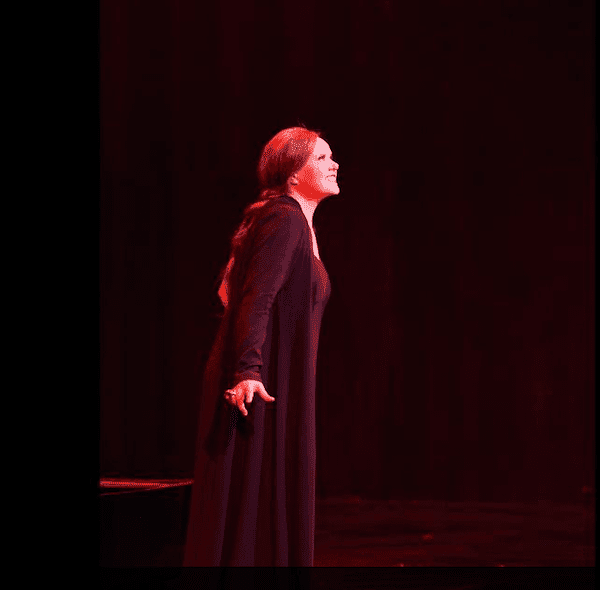
Götterdammerung, the last and longest (6 hours, including two intermissions), did not disappoint. Petra Lang dropped her annoying physical mannerisms—the petulant facial mannerisms, the clenched fists—and stepped confidently into the persona of the mythic Valkyrie, Wotan’s favorite daughter, and became the beloved wife of fallen hero Siegfried. She was magnificent, her voice strong, soaring, often beautiful in its burnished and rich mid-tones. As she sang farewell to her father, and to his dreams of an immortal Valhalla for all the heroes, she was both bitter and heartbroken. Be at peace, she sings to her absent father. Ruhe, o gott—Rest, oh god. In the end, I was convinced by Lang, a brilliant if not charismatic Brunnhilde.
Her Brunnhilde is Adam, disobeying God and paying the price: the loss of Eden, loss of heaven, loss of immortality. Yet she gained the ability to love, something that Wotan sacrificed in order to possess the ring. While Stefan Vincke’s Siegfried had vocal stamina to burn, his tendency to grin inappropriately (perhaps he thought he was playing Parsifal?) robbed many key moments of their power.
Wagner’s Ring is a sacred journey that binds all those who travel it in a deathless fellowship. A fellowship of the ring. The music continually makes us an offer we cannot refuse.
Months later, I am still filled with the power of Wagner’s music—an incomparable achievement in artistic vision. Bravo to the magnificent Vienna Philharmonic orchestra, whose empassioned expertise reforged this Ring with elegance and power.

Dull Blade
by Christina Waters | Oct 22, 2017 | Home |
According to “director” Denis Villeneuve, in the year 2049 women will still be objectified as nubile, pliant toys for men. And men will still wonder why life has no meaning. An old trope—AIs searching for their own identity and searching for a way to become more human than human—is sold out by this lukewarm attempt. Let’s be clear, there are only a few great myths. Stories that can be told over and over again, as long as fresh meaning, insight, or at least enjoyment is injected into them. The minute a corporate committee in search of ticket sales gets a hold of a great narrative, it can be killed before it ever comes to life. Warning: if you loved the original Blade Runner, do not destroy the power of its memory by seeing this castrato of a sequel.
My response to the current dystopic sci-fi flick Blade Runner 2049—which poses as a “sequel” without advancing much beyond the director’s ego—is: “what were they thinking?” Other than the astonishing landscapes of ruined industrial cities and a few tricks of the holographic trade, BR 2049 offers little in the way of breathtaking imagery and nothing in the way of characters, narrative, or freshness. How could so much advance hype add up to so little payoff I wondered as I contemplated walking out after two hours—with another 45 minutes still to go!
Greatly to my shame, I actually stayed and watched the interminable conclusion play out like some pathetic outtake of the original Star Trek series. To understand the full extent of my indignation, let me back up and attempt to sketch out what director Villeneuve (winner of this season’s Darren Aronofsky Narcissism Award) had set out for us.
The film opens as our protagonist—a replicant (android) hunter for the LAPD named K (Ryan Gosling)—sets out to hunt down a long-lost android working a grub farm in the California of the future. Oh, in 2049 there are a new breed of replicants with indefinite lifespans, i.e. time on their hands to ponder their quiet desperation. K is one of them.
K’s airborne vehicle soars over a stunning vista of wall-to-wall industrial farms as far as the eye can see. Pale grey under a dark grey sky. He finds his prey, but he also finds the beginning of a mystery—a monumental lifeless tree, beneath which is buried a box containing skeletal remains. In search of the identity attached to those bones, K is shown through the harrowingly sterile halls of the LAPD archives by a vicious surveillance honcho played by Sylvia Hoeks. Uh-oh. K has stumbled on a mystery that the elites do NOT want known, and Hoeks’ character plants several watchers on his tail. K’s quest points to a meeting with the former blade runner, now missing for 30 years: Rick Deckard (Harrison Ford).

Meanwhile, his own secret investigation lead K to a brilliant scientist with unusual powers of memory, who unlocks a mystery involving a carved toy horse. (No, it doesn’t make any more sense even if you had seen the film.) Replicants, as all students of the original Ridley Scott masterpiece know, are never sure whether their “memories” are their own, or whether they’ve simply been implanted to help give them a reassuring sense of identity. [Great. An overly-long film about immortal androids with identity issues. That was old three generations ago when Carel Capek coined the word “robot” in his drama RUR.]
 While this need to find out more about the identity of the skeletal remains pushes him into forbidden corridors, K begins to form something like a genuine attachment for his holographic girlfriend (played with cloying compassion and a gooey barbie doll smile by Ana der Armas). The third woman in his life is the always watchable Robin Wright, as a very badass LAPD boss with her own authority issues. Wright’s presence, swearing and drinking as tough as any noir cop, gives energy to every minute she’s on screen. She has a soft spot for K, allowing him time and access to areas he shouldn’t be probing, all of which is watched carefully by the diabolical, if robotic Hoeks character.
While this need to find out more about the identity of the skeletal remains pushes him into forbidden corridors, K begins to form something like a genuine attachment for his holographic girlfriend (played with cloying compassion and a gooey barbie doll smile by Ana der Armas). The third woman in his life is the always watchable Robin Wright, as a very badass LAPD boss with her own authority issues. Wright’s presence, swearing and drinking as tough as any noir cop, gives energy to every minute she’s on screen. She has a soft spot for K, allowing him time and access to areas he shouldn’t be probing, all of which is watched carefully by the diabolical, if robotic Hoeks character.
Now at this point, oh say halfway through the film, a better director (armed with MUCH better screenwriters) would have set up some soul-nudging questions. Are all of these people androids? If so, do they know they are? Even if they no longer have the familiar 4 year life spans we recall from the earlier film, long life doesn’t guarantee a sense of humanity. And then there’s the potentially juicy cliché of whether some long-lost android actually did give birth—another existential nugget upon which we might have been invited to chew. I would rather have been offered a gravel crostini. More flavor and emotional traction.
See that’s the deal: Blade Runner 2049 fails on almost every front. There are no stunning techno innovations (just incessant and repetitive CGI overload) nor is there a plot filled with engaging characters (merely robotic performances by allegedly human actors). There is only the weakly-motivated hunt for Rick Deckard which doesn’t even get underway until the beginning of the film’s third hour.
Like many directors without their own story to tell (Ridley Scott had already made his film), Villeneuve began to grow restless after he had recycled all of the silicone bodies, sharp objects, atmospheric lighting, and visual quotes from the original film. He then did what any intellectually bankrupt director does—he began aggressively borrowing from other cultural sources. “Neo, you’re the One,” can practically be overheard in several Big Moments, e.g. where for no reason at all we find Jared Leto babbling Metaphysics 101 platitudes as a blind apocalyptic guru. He also likes to disembowel naked women, but that’s another story.
But wait! We enter an industrial post-nuclear wasteland which is now an orphanage where children retrofit computer parts for a Fagin in fingerless mittens and battered tweed coat. Ed Burtynsky meets Charles Dickens. Now it’s the story of Christ’s nativity, now the digital nymphet turns out to be the squeeze with a heart of gold. Suddenly it’s a holographic carnival of Vegas acts inside the Overlook Hotel in the Shining.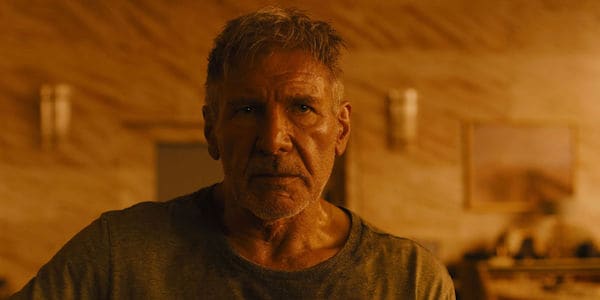
By the time the grizzled-but-ripped Harrison Ford does show up, we are out of popcorn and out of patience.
Ryan Gosling might be a likeable enough lad when tucked inside a small, independent film playing opposite a strong woman who can act, but left all alone—for hours!—in Blade Runner 2049, Gosling resorts to his one facial expression, kicks, punches, and shoots a lot of people, and does plenty of bleeding himself. Unfortunately we just don’t care very much.
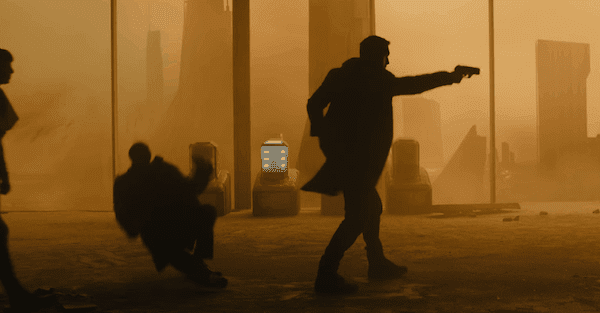
Villeneuve badly needed an editor. The film might have been able to stretch to two hours (with a better script), but it kept on going, with self-indulgent glamour shots slowing down to a crawl simply to fill up the space. Last Year at Marienbad resembles a high speed YouTube promo by comparison. Could this lethargy be due to the committee in charge consulting too many focus groups? Cinematic paralysis sets in during the film’s final half hour.
Full disclosure: My criticisms are partly the laments of someone who loved and studied the original Blade Runner. But even without that background, any filmgoer would have to ask: what’s the point?
 There is another way to look at this film, and that’s across the current ugliness of the mainstream Hollywood film industry itself. In this post-Harvey Weinstein era, it’s hard to stomach the blatantly coarse, cheap, and exploitive characterizations of women. Women, albeit android ones, are reduced to their bodily facades. Shots of gratuitous nudity amount to softcore without a cause. No emotional connection, simply cohabitation. Equally repellant is the amount of brutal violence—by both male and female characters—without any plot justification. How many times do we need to watch people being kicked in the face again and again? [Was this film being aimed at the “ideal” 15-year-old male audience? If so, It was aiming at an audience that wasn’t there.]
There is another way to look at this film, and that’s across the current ugliness of the mainstream Hollywood film industry itself. In this post-Harvey Weinstein era, it’s hard to stomach the blatantly coarse, cheap, and exploitive characterizations of women. Women, albeit android ones, are reduced to their bodily facades. Shots of gratuitous nudity amount to softcore without a cause. No emotional connection, simply cohabitation. Equally repellant is the amount of brutal violence—by both male and female characters—without any plot justification. How many times do we need to watch people being kicked in the face again and again? [Was this film being aimed at the “ideal” 15-year-old male audience? If so, It was aiming at an audience that wasn’t there.]
Finally—and this is the film’s fatal weakness in a nutshell—Blade Runner 2049 gives credibility to an old truism in film and television: you can tell how empty of plot, acting, or invention a film is by how punishingly loud the soundtrack. In Villeneuve’s film, wildly-amplified electronic soundscapes attempt to push us toward some sort of auditory coitus. An onslaught of high-key heavy metal sound design, with a few actors thrown in. Next week, when the film drops into to the web streaming market, watch it in your own home: with the sound off. You’ll be asleep in no time.
**********************
With Ryan Gosling, Sylvia Hoeks, Ana de Armas, and Harrison Ford. Written by Hampton Fancher and Michael Green. Directed by Denis Villeneuve. 163 minutes.

taste of autumn
by Christina Waters | Oct 1, 2017 | Home |
Tomatoes, ripened on the vine—always a sign of the end of summer and the time to feel the approach of autumn.
Some people look at a calendar to know when the seasons change. I have found that it’s not difficult to detect the exquisitely calibrated changes of natural cycles. Listen to the leaves. By the first of September they have lost their spring moisture. The unmistakable sound of dryness is picked up by the autumn breezes. The leaves are dreaming of falling—to make room for winter.
“One August afternoon in Milan, I was wandering through the art deco corridors of the Galleria Vittorio Emanuele, admiring the marble inlays in the cafe-strewn sidewalks, when I spied a conveniently located gelateria. My eyes savored the colors of pistachio, lemon, and mint, but my mouth zeroed in on the brilliant pink of amarena—the slightly sour cherries that grow in Italy.
 Yes, I would like two scoops of that! Somehow the brilliant pink scoop of gelato echoed the architecture of the northern Italian city. It tasted Italian, and so does the memory of that afternoon that returns every time I encounter sweet-tart amarena gelato. Italian foods are about enjoyment of the moment— robust, supple, happy flavors without trickiness and frills. For that, there is French cuisine!
Yes, I would like two scoops of that! Somehow the brilliant pink scoop of gelato echoed the architecture of the northern Italian city. It tasted Italian, and so does the memory of that afternoon that returns every time I encounter sweet-tart amarena gelato. Italian foods are about enjoyment of the moment— robust, supple, happy flavors without trickiness and frills. For that, there is French cuisine!
Cold beer for me is forever fused with the indolent pleasures of Mexican beaches. Exhausted from swimming and body surfing, I say yes every time to a cold Corona with lime. How can you beat the perfect match of the malty ice coldness of the beer and righteous physical weariness on a hot day? These sensations entwine as indelibly as temple ruins, scarlet embroidery, and fresh-caught fish grilled on the beach. Or my mother’s brown sugar brownies: One taste and I’m back in her kitchen scooping the warm cookies onto the silvery wire racks to cool.†[from Inside the Flame: the joy of treasuring what you already have]
Remember some of the flavors that have stayed with you, that have remained favorites throughout your life. Such a pleasure. Savor more from my recent sensory memoir, Inside the Flame.




 Magic realism, at its best, is a delicious elixir of visual and intellectual desire. But at its worst….let’s just say that at many crucial turns, the film implodes through its own lack of discipline. LIke a spoiled child with an expensive paintbox, del Toro indulges almost all of his fetishes whenever possible. His admirable championing of the oppressed becomes scolding and lecturing. His full rainbow of racial and gender operatives is so contrived and self-congratulatory as to grow tedious.
Magic realism, at its best, is a delicious elixir of visual and intellectual desire. But at its worst….let’s just say that at many crucial turns, the film implodes through its own lack of discipline. LIke a spoiled child with an expensive paintbox, del Toro indulges almost all of his fetishes whenever possible. His admirable championing of the oppressed becomes scolding and lecturing. His full rainbow of racial and gender operatives is so contrived and self-congratulatory as to grow tedious. So much talk, talk, talk that could have become shining screen moments if only the lines, and the scenes, had been edited. Instead all the speeches are indulged, as are del Toro’s passion for the golden age of television (Dobey Gillis) and the Busby Berkeley era.
So much talk, talk, talk that could have become shining screen moments if only the lines, and the scenes, had been edited. Instead all the speeches are indulged, as are del Toro’s passion for the golden age of television (Dobey Gillis) and the Busby Berkeley era.


 Sellars, who clearly put little energy or invention into the libretto, seemed content to clip out passages from Dame Shirley’s dispatches and have the singers essentially read them to us. Breaking the most elementary rule of theater, Sellars failed to show us the dramas being told. Even with the entire stage of the opera house he found it impossible to show us any dramatic involvement. The opera is devoid of dramatic tension [an exception, shown above, is a ravishing bit of miner’s camp Shakespeare in the form of scenes from Macbeth.] and reveals precious little in the way of actual engagement between characters. Singers came on, they sang words, the orchestra hurled itself through excruciatingly difficult rhythmic passages and then the giant stump that served as the main showcase was pushed a few feet to the left. And then a few feet back to the right.
Sellars, who clearly put little energy or invention into the libretto, seemed content to clip out passages from Dame Shirley’s dispatches and have the singers essentially read them to us. Breaking the most elementary rule of theater, Sellars failed to show us the dramas being told. Even with the entire stage of the opera house he found it impossible to show us any dramatic involvement. The opera is devoid of dramatic tension [an exception, shown above, is a ravishing bit of miner’s camp Shakespeare in the form of scenes from Macbeth.] and reveals precious little in the way of actual engagement between characters. Singers came on, they sang words, the orchestra hurled itself through excruciatingly difficult rhythmic passages and then the giant stump that served as the main showcase was pushed a few feet to the left. And then a few feet back to the right. The final performance of this world premiere yielded some gorgeous singing by a vibrant young cast, powered by Adams’ beautiful arias for solo voices, soaring through the inane campfire mayhem and barroom boister.
The final performance of this world premiere yielded some gorgeous singing by a vibrant young cast, powered by Adams’ beautiful arias for solo voices, soaring through the inane campfire mayhem and barroom boister.
 In other notable performances, Paul Appleby as luckless miner Joe Cannon brought a clarion tenor voice and persuasive acting to his on-stage antics. As another rabble-rousing miner bass Ryan McKinny offered searing moments of vocal beauty and angst. (McKinny already has at least one Wagner role under his belt, and it would be revelatory to hear Tines as Wotan one of these years.) As the raw-boned denizens of the camps, the SF Opera chorus men attacked the repetitive, Glassian declamations with appropriate bravado.
In other notable performances, Paul Appleby as luckless miner Joe Cannon brought a clarion tenor voice and persuasive acting to his on-stage antics. As another rabble-rousing miner bass Ryan McKinny offered searing moments of vocal beauty and angst. (McKinny already has at least one Wagner role under his belt, and it would be revelatory to hear Tines as Wotan one of these years.) As the raw-boned denizens of the camps, the SF Opera chorus men attacked the repetitive, Glassian declamations with appropriate bravado.

 Wagner’s Ring amounts to a theatrical version of the pilgrimage to Santiago de Compostela. We are all pilgrims, journeying through the voices, the stagecraft, the soaring instrumentation, the multi-dimensional myth, en route to a holy shrine. And yet the route in this case is the shrine, and every note is a sacrament.
Wagner’s Ring amounts to a theatrical version of the pilgrimage to Santiago de Compostela. We are all pilgrims, journeying through the voices, the stagecraft, the soaring instrumentation, the multi-dimensional myth, en route to a holy shrine. And yet the route in this case is the shrine, and every note is a sacrament. Some specifics about this Vienna Staatsopera 2017 production, reviving minimalist but effective staging and sets by Sven-Eric Bechtolf. Small details brought this Ring to moments of great clarity and resonance.In Rheingold, as Wotan fights for possession of the gold ring with the Niebelung Alberich, (Jochen Schmeckenbecher) the stagecraft shows us the two mythical opposites—king of the Gods, and underground-dwelling dwarf—joined by a single crimson cord. Their tug-of-war visually reminds us of how they are united in their greed, and whoever wins the gold, will lose it in the end. That single red cord, the width of the entire stage, was arrestingly eloquent of the Nietzschean tension in these opposing characters.
Some specifics about this Vienna Staatsopera 2017 production, reviving minimalist but effective staging and sets by Sven-Eric Bechtolf. Small details brought this Ring to moments of great clarity and resonance.In Rheingold, as Wotan fights for possession of the gold ring with the Niebelung Alberich, (Jochen Schmeckenbecher) the stagecraft shows us the two mythical opposites—king of the Gods, and underground-dwelling dwarf—joined by a single crimson cord. Their tug-of-war visually reminds us of how they are united in their greed, and whoever wins the gold, will lose it in the end. That single red cord, the width of the entire stage, was arrestingly eloquent of the Nietzschean tension in these opposing characters.



 While this need to find out more about the identity of the skeletal remains pushes him into forbidden corridors, K begins to form something like a genuine attachment for his holographic girlfriend (played with cloying compassion and a gooey barbie doll smile by Ana der Armas). The third woman in his life is the always watchable Robin Wright, as a very badass LAPD boss with her own authority issues. Wright’s presence, swearing and drinking as tough as any noir cop, gives energy to every minute she’s on screen. She has a soft spot for K, allowing him time and access to areas he shouldn’t be probing, all of which is watched carefully by the diabolical, if robotic Hoeks character.
While this need to find out more about the identity of the skeletal remains pushes him into forbidden corridors, K begins to form something like a genuine attachment for his holographic girlfriend (played with cloying compassion and a gooey barbie doll smile by Ana der Armas). The third woman in his life is the always watchable Robin Wright, as a very badass LAPD boss with her own authority issues. Wright’s presence, swearing and drinking as tough as any noir cop, gives energy to every minute she’s on screen. She has a soft spot for K, allowing him time and access to areas he shouldn’t be probing, all of which is watched carefully by the diabolical, if robotic Hoeks character.


 There is another way to look at this film, and that’s across the current ugliness of the mainstream Hollywood film industry itself. In this post-Harvey Weinstein era, it’s hard to stomach the blatantly coarse, cheap, and exploitive characterizations of women. Women, albeit android ones, are reduced to their bodily facades. Shots of gratuitous nudity amount to softcore without a cause. No emotional connection, simply cohabitation. Equally repellant is the amount of brutal violence—by both male and female characters—without any plot justification. How many times do we need to watch people being kicked in the face again and again? [Was this film being aimed at the “ideal” 15-year-old male audience? If so, It was aiming at an audience that wasn’t there.]
There is another way to look at this film, and that’s across the current ugliness of the mainstream Hollywood film industry itself. In this post-Harvey Weinstein era, it’s hard to stomach the blatantly coarse, cheap, and exploitive characterizations of women. Women, albeit android ones, are reduced to their bodily facades. Shots of gratuitous nudity amount to softcore without a cause. No emotional connection, simply cohabitation. Equally repellant is the amount of brutal violence—by both male and female characters—without any plot justification. How many times do we need to watch people being kicked in the face again and again? [Was this film being aimed at the “ideal” 15-year-old male audience? If so, It was aiming at an audience that wasn’t there.]
 Yes, I would like two scoops of that! Somehow the brilliant pink scoop of gelato echoed the architecture of the northern Italian city. It tasted Italian, and so does the memory of that afternoon that returns every time I encounter sweet-tart amarena gelato. Italian foods are about enjoyment of the moment— robust, supple, happy flavors without trickiness and frills. For that, there is French cuisine!
Yes, I would like two scoops of that! Somehow the brilliant pink scoop of gelato echoed the architecture of the northern Italian city. It tasted Italian, and so does the memory of that afternoon that returns every time I encounter sweet-tart amarena gelato. Italian foods are about enjoyment of the moment— robust, supple, happy flavors without trickiness and frills. For that, there is French cuisine!